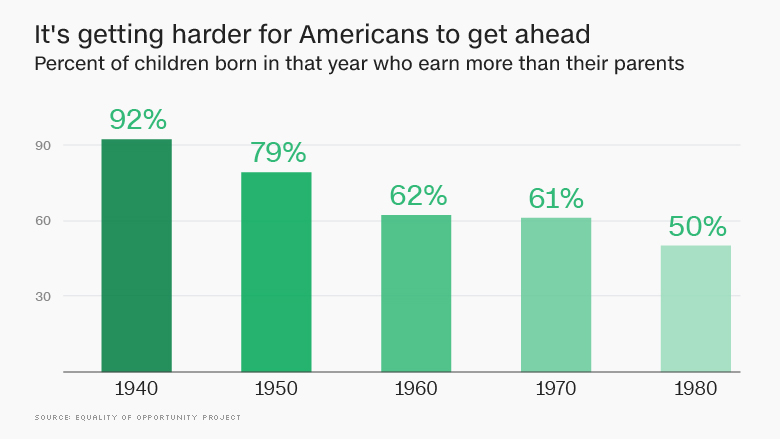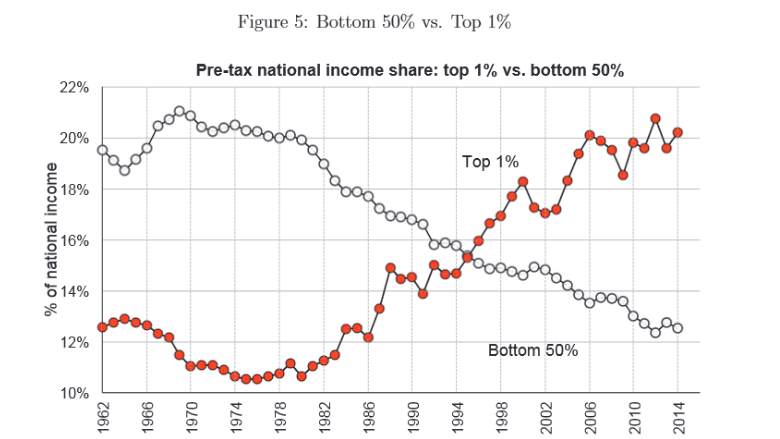On December 22, 2016, Heather Long writes on CNN Money:
The gap between the “haves” and “have nots” is widening, according to the latest data out this week.
The rich are money-making machines. Today, the top mega wealthy — the top 1% — earn an average of $1.3 million a year. It’s more than three times as much as the 1980s, when the rich “only” made $428,000, on average, according to economists Thomas Piketty, Emmanuel Saez and Gabriel Zucman.
Meanwhile, the bottom 50% of the American population earned an average of $16,000 in pre-tax income in 1980. That hasn’t changed in over three decades.
As if that’s not depressing enough, living the American Dream is also getting harder to do.
Millennials, born in the 1980s, only have a 50% likelihood — a coin toss chance — of earning more money than their parents did, according to new research released this month from the Equality of Opportunity Project.
It wasn’t always this way. In the 1940s, almost everyone in America grew up to be better off financially than their parents. While money isn’t the only definition of success, more wealth typically leads to bigger houses, grander vacations, fancier cars and more opportunities to advance.
“Children’s prospects of achieving the ‘American Dream’ of earning more than their parents have fallen from 90% to 50% over the past half century,” the researchers wrote in their report.

Wealthy taking a bigger piece of ‘pie’
The wealthy didn’t always take such a big share of the proverbial “pie.” In the 1970s, a decade generally seen as fairly prosperous, the top 1% of Americans earned just over 10% of all U.S. income (i.e. the “pie”).
Over time, the rich became more lucky — or more greedy. Today the top 1% take home more than 20% of all U.S. income.
As the wealthy earned more, someone else in America had to get less. The bottom 50% went from capturing over 20% of national income for much of the 1970s to earning barely 12% today.
The turning point started around 1980, as seen in the graph below. By the mid-1990s, the fortunes of the top 1% were clearly on the rise and those of the bottom half were declining rapidly.

Wages aren’t going up for bottom 50%
The Great Recession hit everyone hard. While job losses hit the bottom half, the tanking of the stock market and the sharp drop-off in home and property values caused the wealth of the top 1% to also fall dramatically.
Around 2009 and 2010, inequality narrowed slightly because the rich had lost a lot of wealth.
But since then, inequality has grown and is on track to widen further. The wealthy have recovered far faster as the stock market has surged over 230% since bottoming out in March 2009 and property values have shot back up to pre-recession levels.
In the meantime, wages for the bottom aren’t moving.
The U.S. tax system is supposed to help the poor. Yet even after-tax income shows that the bottom 50% averaged just $25,000 a person in 2014, according to the latest data. That’s just a touch above the $20,000 someone in the bottom half earned way back in 1974 (after adjusting for inflation).
“Income has boomed at the top: in 1980, top 1% adults earned on average 27 times more than bottom 50% adults, while they earn 81 times more today,” write Piketty, Saez and Zucman.

Both the cause and the solution is our technological advances.
Why are technological advances the cause? Because tectonic shifts in the technologies of production are displacing the need for human labor and at the same time devaluing the worth of labor. Yet labor is the ONLY means to an earned income that the vast majority of people have.
The role of physical productive capital is to do ever more of the work, which produces income. Full employment is not an objective of businesses. Companies strive to keep labor input and other costs at a minimum in order to maximize profits for the owners. They strive to minimize marginal cost, the cost of producing an additional unit of a good, product or service once a business has its fixed costs in place. Reducing marginal costs enables businesses to increase profits, offer goods, products and services at a lower price, or both. Increasingly, new technologies are enabling companies to achieve near-zero cost growth without having to hire people. Thus, private sector job creation in numbers that match the pool of people willing and able to work is constantly being eroded by physical productive capital’s ever increasing role.
Over the past century there has been an ever-accelerating shift to productive capital––which reflects tectonic shifts in the technologies of production. The mixture of labor worker input and capital worker input has been rapidly changing at an exponential rate of increase for over 235 years in step with the Industrial Revolution (starting in 1776) and had even been changing long before that with man’s discovery of the first tools, but at a much slower rate. Up until the close of the nineteenth century, the United States remained a working democracy, with the production of products and services dependent on labor worker input. When the American Industrial Revolution began and subsequent technological advance amplified the productive power of non-human capital, plutocratic finance channeled its ownership into fewer and fewer hands, as we continue to witness today with government by the wealthy evidenced at all levels. People invented tools to reduce toil, enable otherwise impossible production, create new highly automated industries, and significantly change the way in which products and services are produced from labor intensive to capital intensive––the core function of technological invention.
Most changes in the productive capacity of the world since the beginning of the Industrial Revolution can be attributed to technological improvements in our capital assets, and a relatively diminishing proportion to human labor. Capital does not “enhance” labor productivity (labor’s ability to produce economic goods). In fact, the opposite is true. It makes many forms of labor unnecessary.
Why are technological advances the solution? Because productive capital is increasingly the source of the world’s economic growth. Therefore, productive capital should become the source of added property ownership incomes for all. Simply put, if both labor and capital are independent factors of production, and if capital’s proportionate contributions are increasing relative to that of labor, then equality of opportunity and economic justice demands that the right to property (and access to the means of acquiring and possessing property) must in justice be extended to all.
The system of big government and socialistic programs funded by tax extraction and non-asset-based national debt are not the answer to anything. The socialistic system almost always results in increased oppression, increased poverty or sameness as EVERY citizen becomes dependent on the State.
What we need is a system that empowers individuals and families to become fully productive, be creative, build businesses and to take care of themselves. The MOST IMPORTANT need is to extend equal opportunity to EVERY child, woman, and man to share individually in the FUTURE wealth-creating, income-producing capital assets of corprations whereby financing new capital formation and transfers of existing assets is accomplished from the bottom-up and without redistributing property rights of the rich and super-rich with regard to their existing assets
Instead, we have a system where all power and all wealth are increasingly controlled by giant banks and giant corporations that are in turn controlled by the global elite. The “financialization” of the global economy has turned almost everyone on the planet into “deft serfs,” and the compound interest on all of that debt enables the global elite to constantly increase their giant piles of money.
Not only has EVERY person become a debt slave, but also a wage slave, and increasingly a welfare and charity slave. Over the past four decades the total amount of consumer debt in America has gone from about 2.2 trillion dollars to nearly 60 trillion dollars. As Snyder notes, “many of us work as ‘debt serfs’ our entire lives, and we never even know the names or the faces of those that we are making rich as we slowly pay off our debts.”
Most thinking people should realize that never-ending consumer is not a wise situation to put one into. Such consumer debt requires a source of income that is promised to be paid to the owners of the note, credit card, or mortgage.
But there is a good form of debt, which is constantly used by the rich and the super-rich to make themselves richer. It is capital credit, a loan specifically tailored to finance FUTURE investment, repayable out of FUTURE earnings, without the need for “past savings” or the reduction in one’s personal consumption needs and wants. In the business world, physical capital is expected to go on producing income indefinitely with proper maintenance and with restoration in the technical sense through research and development. This is how technological advances occur and develop over time.
While other forms of non-asset-based debt is inflationary, commercial capital credit relies on non-inflationary capital asset creation, unlike government expenditures which rely on tax extraction or non-asset-backed debt to redistribute or inject inflationary money into the system.
The socialism practiced today relies on tax extraction and non-asset-based national debt to firstly redistribute monies collected into social welfare programs and second to finance public infrastructure and the military, etc. To the extent that modern “capitalistic” economies redistribute they are practicing socialism.
For those who are interested in the specifics of the solution see the Just Third Way and the Capital Homestead Act – the purpose of which is to eliminate privilege and provide EQUAL OPPORTUNITY for EVERY child, woman and man to build independent, sustainable financial security and incomes through acquiring ownership in FUTURE wealth-creating, income-producing capital assets financed without the necessity of pledging “past savings” or a reduction in consumption.
The solution eliminates the barriers to ordinary people forming capital themselves in association with others without the necessity for “past savings” or the pledging of equities which only the wealthy ownership class has.
The JUST Third Way is a radical overhaul of the economic system (i.e., the Federal tax system, Federal Reserve policy, inheritance law, welfare and entitlement system, etc.) that will achieve genuine economic democracy, based on the Platform of the Unite America Party and its links and the proposed Capital Homestead Act. Our Platform is a call for a vision of political economy that can unite the left and the right, based on binary economist Louis Kelso’s ownership-based paradigm. Now is the time to cure America’s political cancer (Crony Capitalism) and restore America to again becoming a model for global citizens in all countries.
For a new vision see http://www.foreconomicjustice.org/?p=12331 andwww.facebook.com/uniteamericaparty. Support the Unite America Party Platform, published by The Huffington Post at http://www.huffingtonpost.com/gary-reber/platform-of-the-unite-ame_b_5474077.html as well as OpEd News at http://www.opednews.com/articles/Platform-of-the-Unite-Amer-by-Gary-Reber-Party-Leadership_Party-Platforms-DNC_Party-Platforms-GOP-RNC_Party-Politics-Democratic-140630-60.html.
Support the Capital Homestead Act at http://www.cesj.org/learn/capital-homesteading/capital-homestead-act-a-plan-for-getting-ownership-income-and-power-to-every-citizen/ and http://www.cesj.org/learn/capital-homesteading/capital-homestead-act-summary/.

